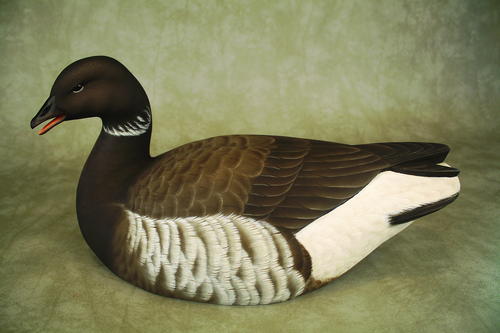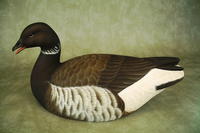Pacific Brant, Part One
A noted waterfowl carver sets out to capture "the essence of the species."

People often ask me what my favorite bird is. My usual response is my favorite bird is the one I am currently working on. That is because I enjoy the research and planning that goes into each project. I find that one of the most intriguing aspects of our art form.
With that in mind, one of my all-time favorite birds is the brant. We have 500 to 600 Pacific or black brant that spend every winter on San Diego Bay and I have spent many hours observing them. I especially enjoy their rapid flight just above the water and their incessant chatter, although their high-pitched call sounds a bit undignified for such a magnificent bird.
As I see them on the water, their short, normally erect necks and high white rumps really stand out. Although the neck collars of both species vary greatly, the black brant tends to have a larger, more definite collar. When carving I prefer this to break up the long dark expanse of the head and neck. In fact, I normally exaggerate the neck collar on my carvings. Another characteristic of both species, frequently missed by the casual observer, is that the last several side pocket feathers are dark and lack the white tips of the rest of the side pocket. This helps highlight the white rump on our carvings.
All my projects start on the drawing board. I’ll make several sketches (some detailed, some not) in an attempt to capture the “essence of the species.” For this project I chose a sketch with a slight “S” curve to the neck and downward tilt to the head. I planned to carve an open bill. This pose seemed appropriate to me.
Once I draw the pattern I transfer it to poster board, which I find much handier during the carving process. The easy way to do this is to draw the pattern with a 5 mm HB lead pencil, turn it over onto the poster board, and then rub the back of the pattern with a fingernail or other firm object. This will transfer the pattern to the poster board. I then cut out the patterns with an X-acto or other sharp knife. Then it’s time to start carving.
Read the rest of this article in Wildfowl Carving Magazine's Fall 2013 issue.
Read NextThe Littlest Falcon



